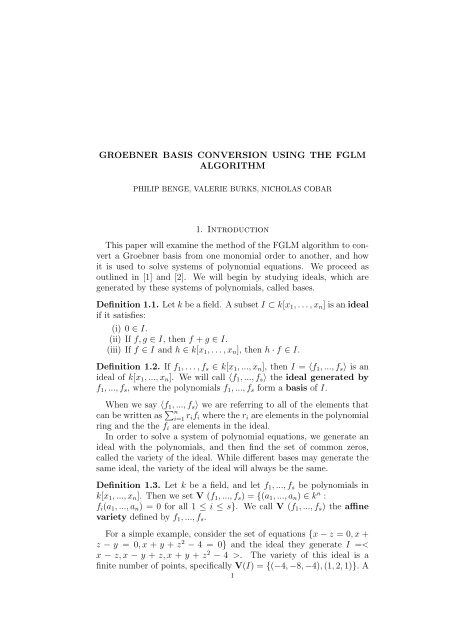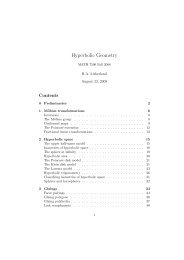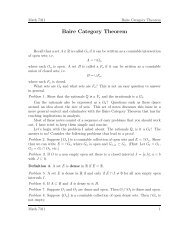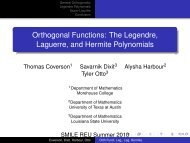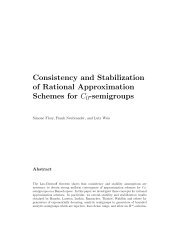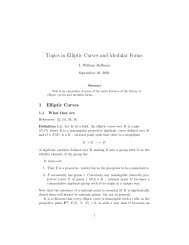GROEBNER BASIS CONVERSION USING THE FGLM ALGORITHM ...
GROEBNER BASIS CONVERSION USING THE FGLM ALGORITHM ...
GROEBNER BASIS CONVERSION USING THE FGLM ALGORITHM ...
Create successful ePaper yourself
Turn your PDF publications into a flip-book with our unique Google optimized e-Paper software.
<strong>GROEBNER</strong> <strong>BASIS</strong> <strong>CONVERSION</strong> <strong>USING</strong> <strong>THE</strong> <strong>FGLM</strong><br />
<strong>ALGORITHM</strong><br />
PHILIP BENGE, VALERIE BURKS, NICHOLAS COBAR<br />
1. Introduction<br />
This paper will examine the method of the <strong>FGLM</strong> algorithm to convert<br />
a Groebner basis from one monomial order to another, and how<br />
it is used to solve systems of polynomial equations. We proceed as<br />
outlined in [1] and [2]. We will begin by studying ideals, which are<br />
generated by these systems of polynomials, called bases.<br />
Definition 1.1. Let k be a field. A subset I ⊂ k[x1,...,xn] is an ideal<br />
if it satisfies:<br />
(i) 0 ∈ I.<br />
(ii) If f,g ∈ I, then f + g ∈ I.<br />
(iii) If f ∈ I and h ∈ k[x1,...,xn], then h · f ∈ I.<br />
Definition 1.2. If f1,...,fs ∈ k[x1,...,xn], then I = 〈f1,...,fs〉 is an<br />
ideal of k[x1,...,xn]. We will call 〈f1,...,fs〉 the ideal generated by<br />
f1,...,fs, where the polynomials f1,...,fs form a basis of I.<br />
When we say 〈f1,...,fs〉 we are referring to all of the elements that<br />
can be written as �n i=1 rifi where the ri are elements in the polynomial<br />
ring and the the fi are elements in the ideal.<br />
In order to solve a system of polynomial equations, we generate an<br />
ideal with the polynomials, and then find the set of common zeros,<br />
called the variety of the ideal. While different bases may generate the<br />
same ideal, the variety of the ideal will always be the same.<br />
Definition 1.3. Let k be a field, and let f1,...,fs be polynomials in<br />
k[x1,...,xn]. Then we set V (f1,...,fs) = {(a1,...,an) ∈ k n :<br />
fi(a1,...,an) = 0 for all 1 ≤ i ≤ s}. We call V (f1,...,fs) the affine<br />
variety defined by f1,...,fs.<br />
For a simple example, consider the set of equations {x − z = 0,x +<br />
z − y = 0,x + y + z 2 − 4 = 0} and the ideal they generate I =<<br />
x − z,x − y + z,x + y + z 2 − 4 >. The variety of this ideal is a<br />
finite number of points, specifically V(I) = {(−4, −8, −4), (1, 2, 1)}. A<br />
1
2 PHILIP BENGE, VALERIE BURKS, NICHOLAS COBAR<br />
variety does not have to be a finite set of points, but if it is, the ideal<br />
is called zero-dimensional.<br />
In order to study these ideals and their bases, a standard must be<br />
set for the way in which the polynomials are written. This is essential<br />
because the division algorithm, which is associative in single variable<br />
calculations, is not associative when multiple variables are involved.<br />
Also, what would constitute a Groebner basis under one monomial<br />
order would not necessarily be the same under another.<br />
Definition 1.4. A monomial ordering on k[x1,...,xn] is any relation<br />
> on Z n ≥0, or equivalently, any relation on the set of monomials<br />
x α ,α ∈ Z n ≥0, satisfying:<br />
(1) > is a total (or linear) ordering on Z n ≥0.<br />
(2) If α > β and γ ∈ Z n ≥0, then α + γ > β + γ.<br />
(3) > is a well-ordering on Z n ≥0. This means that every nonempty<br />
subset of Z n ≥0 has a smallest element under >.<br />
Within polynomials, the monomials are generally written in descending<br />
order. Within the monomial itself, individual variables are also<br />
written in descending order with x1 > x2 > ... > xn. To determine<br />
precedence under a monomial ordering, the exponents of the variables<br />
in a monomial are written as an ordered n-tuple to allow the reader to<br />
find the vector difference. An example of each type of monomial ordering<br />
will be given using the monomials x1x 2 2 and x 3 2x 4 3. The n-tuples<br />
for these monomials (represented by α and β) are α = (1, 2, 0) and<br />
β = (0, 3, 4), respectively.<br />
Three commonly used monomial orders are lexicographic, graded<br />
lexicographic, and graded reverse lexicographic. In lexicographic order,<br />
or lex, a monomial with degree α is greater than another monomial with<br />
degree β if and only if the left-most, non-zero component of α − β is<br />
greater than 0. In graded lexicographic, or grlex, the monomial with<br />
the higher total degree is greater than the other. If the monomials’<br />
degrees are equal, then we use lex to break the tie. Finally, graded<br />
reverse lexicographic, also called grevlex, is exactly like grlex in that<br />
it first compares the degrees of the monomials, and the one with the<br />
higher degree is taken to be greater. However, in the event of equal<br />
degrees, it does not revert back to lex ordering to break ties. Instead a<br />
monomial with degree α is greater than another monomial with degree<br />
β if the right-most, non-zero component of α − β is less than 0.<br />
Example 1.5.<br />
(1) x1x 2 2 >lex x 3 2x 4 3 since α − β = (1, −1, −4).<br />
(2) x1x 2 2
<strong>GROEBNER</strong> <strong>BASIS</strong> <strong>CONVERSION</strong> <strong>USING</strong> <strong>THE</strong> <strong>FGLM</strong> <strong>ALGORITHM</strong> 3<br />
(3) x1x 2 2 <br />
be a monomial order. Then the multidegree of f is multideg(f) =<br />
max{α ∈ Zn ≥0 : aα �= 0} (the maximum is taken with respect to >).<br />
The leading coefficient of f is LC(f) = amultideg(f) ∈ k, and the<br />
leading monomial of f is LM(f) = xmultideg(f) (with coefficient 1).<br />
The leading term of f is LT(f) = LC(f) · LM(f). For example, if<br />
f = 3x3y2 − x3y + x2 − y, then multideg(f) = (3, 2, 0), LC(f) = 3,<br />
LM(f) = x3y2 , and the LT(f) = 3x3y2 with respect to lexicographic<br />
order.<br />
Definition 1.6. Fix a monomial order. A finite subset G = {g1,...,gt}<br />
of an ideal I is said to be a Groebner basis if<br />
< LT(g1),...,LT(gt) > = < LT(I) >. A Groebner basis is call reduced<br />
if<br />
(1) LC(p) = 1 for all p ∈ G.<br />
(2) For all p ∈ G, no monomial of p lies in 〈LT(G − {p})〉.<br />
This means that the leading term of any element of I must be divisible<br />
by one of the LT(gi) for G to be a Groebner basis. To divide<br />
polynomials we use the following division algorithm:<br />
Definition 1.7. Fix a monomial order > on Z n ≥0, and let F = (f1,...,fs)<br />
be an ordered s-tuple of polynomials in k[x1,...,xn]. Then every<br />
f ∈ k[x1,...,xn] can be written as<br />
f = a1f1 + ... + asfs + r,<br />
where ai,r ∈ k[x1,...,xn], and either r = 0 or r is a linear combination,<br />
with coefficients in k, of monomials, none of which is divisible by any<br />
of LT(f1),...,LT(fs). We will call r a remainder of f on division by<br />
F. Furthermore if ai,fi �= 0, then we have<br />
multideg(f) ≥ multideg(aifi).<br />
For example, consider the ideal I =< x 2 + y 2 + z 2 − 2x,x 3 − yz −<br />
x,x − y + 2z >. Take the monomial order graded lexicographic. Then<br />
a Groebner basis, G, for I is G = {x − y + 2z, 2y 2 − 4yz + 5z 2 − 2y +<br />
4z, 3yz 2 + 4z 3 − 10yz + 11z 2 , 375z 4 + 974z 3 − 1460yz + 144z 2 }.<br />
Groebner bases have some very useful properties. In the case of<br />
determining if a function f ∈ k[x1,...,xn] is in an ideal, I, simply<br />
divide f by a Groebner basis for I and then f ∈ I if and only if the<br />
remainder is zero. For example, let I and G be as stated above, and
4 PHILIP BENGE, VALERIE BURKS, NICHOLAS COBAR<br />
f = 14xy − 2z + 3. Then dividing f by G = {g1,g2,g3,g4} using<br />
the division algorithm yields f = 14y · g1 + 7 · g2 + r, where r =<br />
−35z 2 + 14y − 30z + 3. Since r �= 0, f /∈ I.<br />
We would like to mention that a reduced Groebner basis is unique<br />
with respect to a monomial ordering, and from that, two ideals are<br />
equal if and only if their reduced Groebner bases with respect to a<br />
monomial ordering are equal.<br />
We note that an ideal I is zero-dimensional if and only if it satisfies<br />
the following criteria:<br />
Theorem 1.8. Let V=V(I) be an affine variety in Cn and fix a monomial<br />
ordering in C[x1,...,xn]. Then the following statements are equivalent:<br />
(1) V is a finite set.<br />
(2) For each i, 1 ≤ i ≤ n, there is some mi ≥ 0 such that x mi<br />
i ∈<<br />
LT(I) >.<br />
(3) Let G be a Groebner basis for I. Then for each i, 1 ≤ i ≤ n,<br />
there is some mi ≥ 0 such that x mi<br />
i = LM(gi) for some gi ∈ G.<br />
(4) The C-vector space S = span(xα : xα /∈< LT(I) >) is finitedimensional.<br />
(5) The C-vector space C[x1,...,xn]/I is finite-dimensional.<br />
The proof of this theorem is non-trivial, however the proof goes<br />
beyond the scope of this paper. As we can see, if we have a zerodimensional<br />
ideal, then for each variable xi, there is a polynomial in<br />
the Groebner basis for I with a power of xi as a leading monomial.<br />
Consider the following example of a zero-dimensional ideal.<br />
Example 1.9. Let I =< xy 3 − x 2 ,x 3 y 2 − y > in R[x,y]. Using grlex<br />
the Groebner basis is G = {x 3 y 2 − y,x 4 − y 2 ,xy 3 − x 2 ,y 4 − xy}<br />
and 〈LT(I)〉 = 〈x 3 y 2 ,x 4 ,xy 3 ,y 4 〉. We can draw a picture in Z 2 ≥0 to<br />
represent the exponent vectors of the monomials in 〈LT(I)〉 and its<br />
complement as follows. The vectors<br />
α(1) = (3, 2),<br />
α(2) = (4, 0),<br />
α(3) = (1, 3),<br />
α(4) = (0, 4)<br />
are the exponent vectors of the generators of 〈LT(I)〉. Thus, the elements<br />
of ((3, 2) + Z 2 ≥0) ∪ ((4, 0) + Z 2 ≥0) ∪ ((1, 3) + Z 2 ≥0) ∪ ((0, 4) + Z 2 ≥0)<br />
are the exponent vectors of monomials in 〈LT(I)〉. As a result, we can<br />
represent the monomials in 〈LT(I)〉 by the integer points in the shaded<br />
region in Z 2 ≥0 shown below in Figure 1.
<strong>GROEBNER</strong> <strong>BASIS</strong> <strong>CONVERSION</strong> <strong>USING</strong> <strong>THE</strong> <strong>FGLM</strong> <strong>ALGORITHM</strong> 5<br />
Figure 1<br />
2. The <strong>FGLM</strong> Algorithm<br />
The difficulties that arise from trying to compute reduced Groebner<br />
bases with respect to lex ordering can seem insurmountable and enough<br />
to render Groebner bases useless. Fortunately there exists a way to<br />
circumvent some of the difficulties. The aptly-named <strong>FGLM</strong> algorithm<br />
was developed by J.C. Faugère, P. Gianni, D. Lazard, and T. Mora.<br />
As mentioned earlier, it allows one to take a Groebner basis from the<br />
relatively easy calculations of a grevlex ordering and convert it to the<br />
reduced Groebner basis for the same ideal with respect to another<br />
monomial ordering. The drawback to this algorithm is that it only<br />
applies to zero-dimensional ideals. This will be explained in a later<br />
section. In the algorithm, we will be converting a non-lex Groebner<br />
basis to lex Groebner basis, but the <strong>FGLM</strong> algorithm can be used<br />
to convert a Groebner basis from any monomial order to any other<br />
monomial order.<br />
First, of course, one must have an initial Groebner basis, G, with<br />
respect to an initial monomial order. The algorithm then progresses<br />
through three steps for each of the monomials in the ring k[x1,...,xn]<br />
in increasing lex order. At the beginning of each loop, there will be two<br />
sets: Glex, which is initially empty but will become the new Groebner<br />
basis for the desired monomial order, and Blex, which is also initially<br />
empty but will grow to be the lex monomial basis of the quotient ring<br />
k[x1,...,xn]/I as a k-vector space.<br />
The <strong>FGLM</strong> algorithm consists of three main parts.
6 PHILIP BENGE, VALERIE BURKS, NICHOLAS COBAR<br />
(1) Main Loop: For this first step the user will take the current<br />
input monomial x α , initially 1, and find the remainder under<br />
division by G, denoted x αG . Recall that G is the Groebner<br />
basis of the ideal with respect to the original monomial ordering.<br />
There are two possible cases for what will happen to the<br />
remainder. For the first, if x αG is linearly dependent on the<br />
remainders of the other members of Blex, then we have a linear<br />
combination such that<br />
xαG − �<br />
cjxα(j)G = 0<br />
j<br />
where x α(j) ∈ Blex and cj ∈ k. This implies that g = x α −<br />
�<br />
j cjx α(j) ∈ I. So we add g to the list Glex as the last element.<br />
Because we work through the various x α in increasing order<br />
with respect to the new ordering, a polynomial g that is added<br />
to Glex will always have x α with a coefficient of 1 as its leading<br />
term.<br />
In the second case, x αG is linearly independent of the remainders<br />
of the items in Blex. In this event, x α is added to Blex.<br />
If the first case applied and we added a polynomial to Glex,<br />
then Glex must be tested to see if it is the desired Groebner<br />
basis. To do this, we use the Termination Test, the second part<br />
of the <strong>FGLM</strong> algorithm.<br />
(2) Termination Test: In the event that a new polynomial, g, was<br />
added to Glex, the user must compute LT(g). If LT(g) is a<br />
power of xi, where xi is the greatest variable in the new monomial<br />
ordering, then the algorithm terminates. Otherwise, proceed<br />
to the third part of the algorithm, the Next Monomial<br />
step.<br />
(3) Next Monomial: In this phase of the algorithm, simply replace<br />
the x α that has just been processed with the next monomial<br />
with respect to the new order which is not divisible by any of<br />
the leading terms of the polynomials in Glex.<br />
The user repeats the steps of this algorithm until the conditions are<br />
met for the Termination Test.<br />
Notice that whenever a polynomial g is added to Glex, its leading<br />
term is LT(g) = x α with coefficient 1, hence each basis element must<br />
be monic. Also, because the leading term of each basis element is<br />
linearly independent of the leading terms of all other elements, the<br />
Groebner basis obtained from this algorithm must be reduced. The
<strong>GROEBNER</strong> <strong>BASIS</strong> <strong>CONVERSION</strong> <strong>USING</strong> <strong>THE</strong> <strong>FGLM</strong> <strong>ALGORITHM</strong> 7<br />
following example fully demonstrates the algorithm for the reader to<br />
clearly see how it works before we present the proof.<br />
3. Example<br />
We will use the <strong>FGLM</strong> algorithim to find a lexicographic order (with<br />
x > y > z) Groebner basis for the ideal I =< x 2 + 2y 2 − y − 2z,x 2 −<br />
8y 2 +10z−1,x 2 −7yz > from the graded reverse lexicographic Groebner<br />
basis, G = {980z 2 − 18y − 201z + 13, 35yz − 4y + 2z − 1, 10y 2 − y −<br />
12z + 1, 5x 2 − 4y + 2z − 1}. We start with the least variable in the<br />
monomial order, z, and consider it raised to the 0 degree. We then<br />
calculate the remainder of z 0 under division by G. We then continue<br />
increasing the degree of z and finding remainders under division by G<br />
until we find a remainder that is linearly dependent upon the other<br />
remainders. This linearly dependent remainder is subtracted from the<br />
dividend for which it corresponds and this polynomial is added to the<br />
set making up the Groebner basis.<br />
z 0G = 1 G = 1<br />
z G = z<br />
z 2G = 9<br />
490<br />
z 3G = 2817<br />
480200<br />
201 13 y + z − 980 980<br />
y + 26653<br />
960400<br />
z − 2109<br />
960400<br />
Since z 3G is a linear combination of 1 G , z G , and z 2G ,<br />
g1 = z 3 − 313<br />
980 z2 + 37 1<br />
z +<br />
980 490<br />
is the first polynomial added to Glex.<br />
Now we consider the next variable in the monomial order, y. We<br />
again take the remainder with respect to G.<br />
yG = y<br />
We find y itself can be expressed as a linear combination, namely<br />
y = 490<br />
9 z2G − 67<br />
6 zG + 13<br />
18<br />
and subsequently<br />
g2 = y − 490<br />
9 z2 + 67 13<br />
z −<br />
6 18<br />
is added to Glex.<br />
Lastly we consider the greatest variable in the order, x.<br />
x G = x<br />
x2G = 4 2 1 y − z + 5 5 5<br />
Now x2G can be expressed in relation to yG and zG and accordingly<br />
g3 = x 2 − 392<br />
9 z2 + 28 7<br />
z −<br />
3 9
8 PHILIP BENGE, VALERIE BURKS, NICHOLAS COBAR<br />
is the final function added to Glex, leaving us with<br />
Glex = {g1,g2,g3},<br />
our desired lex Groebner basis.<br />
Before we show that the <strong>FGLM</strong> algorithm is a valid method for<br />
changing the ordering of a Groebner basis, we will state the following<br />
lemma:<br />
Lemma 3.1. (Dickson’s Lemma) Given an infinite list x α(1) ,x α(2) ,...<br />
of monomials in k[x1,...,xn], there is an N ∈ N such that every x α(i)<br />
is divisible by one of x α(1) ,...,x α(N) .<br />
Theorem 3.2. The algorithm described above terminates on every input<br />
Groebner basis, G, that generates a zero-dimensional ideal I, and<br />
correctly computes a lex Groebner basis, Glex, for I and the lex monomial<br />
basis, Blex, for the quotient ring k[x1,...,xn]/I.<br />
Proof. We begin with the key observation that monomials are added<br />
to the list Blex in strictly increasing lex order. Similarly, if Glex =<br />
{g1,...,gk}, then<br />
LT(g1) lex ... >lex xn. We<br />
will prove that Glex is a lex Groebner basis for I by contradiction. Suppose<br />
there were some g ∈ I such that LT(g) is not a multiple of any
<strong>GROEBNER</strong> <strong>BASIS</strong> <strong>CONVERSION</strong> <strong>USING</strong> <strong>THE</strong> <strong>FGLM</strong> <strong>ALGORITHM</strong> 9<br />
of the LT(gi), i = 1,...,k. Without loss of generality, we may assume<br />
that g is reduced with respect to Glex.<br />
If LT(g) is greater than LT(gk) = x a1<br />
1 , then one easily sees that<br />
LT(g) is a multiple of LT(gk). Hence, this case cannot occur, which<br />
means that<br />
LT(gi) < LT(g) ≤ LT(gi+1)<br />
for some i < k. But recall that the algorithm places monomials into<br />
Blex in strictly increasing order, and the same is true for the LT(gi).<br />
All the non-leading monomials in g must be less than LT(g) in the<br />
lex order. They are not divisible by any of LT(gj) for j ≤ i, since<br />
g is reduced. So, the non-leading monomials that appear in g would<br />
have been included in Blex by the time LT(g) was reached by the Next<br />
Monomial procedure, and g would have been the next polynomial after<br />
gi included in Glex. This contradicts our assumption on g, which proves<br />
that Glex is a lex Groebner basis for I.<br />
To find a monomial basis for k[x1,...,xn]/I, we need to find all<br />
monomials not in 〈LT(g)〉 for all g ∈ Glex. But Blex contains all such<br />
monomials, so Blex forms a monomial basis for the quotient ring as a<br />
k-vector space. So Blex consists of all monomials determined by the<br />
Groebner basis Glex. �<br />
If I were not a zero dimensional ideal, then some monomial would<br />
always yield a linearly independent remainder, and the Main Loop<br />
would never terminate. By Moeller and Mora [3] we know the upperbound,<br />
call it B, of the total degree of a Groebner basis to be<br />
((n + 1)(d + 1) + 1) (n+1)2s+1<br />
where n is the number of variables in the<br />
ideal, d is the total degree of the ideal, and s is the dimension of the<br />
ideal. To assure termination on a positive dimensional ideal, if we know<br />
B, then for each monomial x, the main loop would need only to run<br />
up to x B , and terminate if the loop does not do so before x B . However,<br />
because the upper bound of the total degree grows rapidly as the<br />
dimension of the ideal increases, it is practical to only use the <strong>FGLM</strong><br />
algorithm on zero dimensional ideals.<br />
4. Conclusion<br />
Finding Groebner bases with respect to lexicographic order is useful<br />
because of the algorithm’s ability to eliminate the largest term in<br />
at least one of the basis elements which makes solving a system of<br />
polynomial equations much easier. Consider a group of polynomial<br />
equations f1,...,fs. These equations determine I = 〈f1,...,fs〉 and to<br />
solve this system, we want to find V(I). If we compute V(I) using<br />
a lex Groebner basis, then we will get equations g1,...,gt forming the
10 PHILIP BENGE, VALERIE BURKS, NICHOLAS COBAR<br />
Groebner basis. Using the property of lexicographic order mentioned<br />
above, we can then back substitute to find the solutions to the system.<br />
However, finding the lexicographic Groebner basis directly can be computationally<br />
expensive. For example, the lexicographic Groebner basis<br />
for I =< x 5 + y 5 + z 5 − 1,x 3 + y 3 + z 2 − 1 > contains a polynomial<br />
with 415 terms, total degree of 37, with a largest coefficient of<br />
141,592,532,029,352. It is instead more efficient to find a Grobner Basis<br />
with respect to the graded reverse lexicographic order, and then<br />
use the <strong>FGLM</strong> algorithm to convert the basis to lexicographic order.<br />
The Groebner basis in graded reverse lexicographic order for the above<br />
ideal is considerably less pathological: the largest polynomial has 38<br />
terms, total degree of 11, and the largest coefficient is 7. The <strong>FGLM</strong><br />
algorithm allows us to more efficiently compute lexicographic Groebner<br />
bases, which have a wide range of applications.<br />
Acknowledgements<br />
The authors thank Robert Lax for his thought provoking lectures,<br />
Jesse Taylor for helpful discussions concerning this paper, and the VI-<br />
GRE program for our funding.<br />
References<br />
[1] Cox, D., Little, J., and O’Shea, D. (2007). Ideals, Varieties, and Algorithms<br />
(3 rd ed.). New York: Springer.<br />
[2] Cox, D., Little, J., and O’Shea, D. (1998). Using Algebraic Geometry. New<br />
York: Springer.<br />
[3] Moeller, H. M., and Mora, F. (1984). Upper and lower Bound for the degree<br />
of Groebner bases, Lecture Notes in Computer Science, 174, 172-183.


